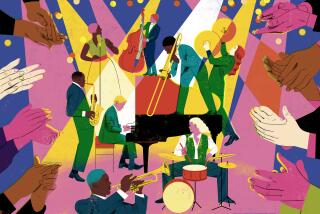Big Easy Plays Up Satchmo’s Roots
NEW ORLEANS — Although three decades have passed since Louis Armstrong’s death, his importance to this city only seems to be growing. So officials are making a big effort to mark the jazz legend’s 100th birthday next month.
Armstrong, who spent much of his adult life in Chicago and New York, was born here Aug. 4, 1901. He always said his birthday was July 4, 1900, which is why Armstrong centennial festivals around the world began in earnest last year. A New Orleans researcher, Tad Jones, discovered baptism records that proved when he was really born.
“He was the most widely known New Orleanian in the world and certainly has been more instrumental than many in making New Orleans the popular and familiar place that it is,” says Jackie Harris, director of the New Orleans Music and Entertainment Commission.
Once Armstrong left New Orleans, he rarely returned because he did not like the idea of playing in segregated bands or for segregated crowds. The place he was born and the building he lived in as a child have long since been razed--and no plaques mark the spots.
But with New Orleans’ population shrinking and its lagging economy ever more dependent on tourism, the city increasingly is playing up its role in the development of one of America’s most popular cultural exports, jazz, and its No. 1 icon, Armstrong.
“They should recognize him because of who he was and what he did for New Orleans,” says jazz star Wynton Marsalis, a New Orleans native.
Organizers of the four-day Satchmo Summerfest that runs here Aug. 2-5 will open the events with a ceremony renaming New Orleans International Airport for ol’ Pops.
On the night of Armstrong’s birthday, Ellis Marsalis, along with performing sons Branford, Delfeayo, Jason and Wynton, will put on a show at the University of New Orleans, where Ellis has taught jazz since 1989. Joining them will be Harry Connick Jr., one of the elder Marsalis’ former students at the city’s arts and music high school.
Only once before has Ellis Marsalis, who is planning to retire from teaching, played publicly with his four musical sons (one brother does not play professionally).
The family thought it would be ideal to celebrate both the father’s career and Armstrong’s birthday together, Wynton Marsalis said, adding that Armstrong “is the one who taught all of us how to play. He taught the whole world about jazz.”
The concert is a highlight of a weekend of panel discussions, lectures and other events that will bring together jazz scholars from around the world and musicians who once played with Armstrong. Also planned: a jazz Mass at St. Augustine Church, the nation’s oldest black Roman Catholic church.
Jones will give one of the talks and a tour pointing out the otherwise unrecognizable spots where Armstrong was born, grew up and developed his versatile, upbeat and engaging style.
“His music, his walk, his talk, his entire being spoke New Orleans. It’s something he couldn’t luckily get rid of and something he didn’t want to get rid of,” Jones says.
In 1980, the city named a park for Armstrong just outside the French Quarter at an area also known as Congo Square--where jazz is thought to have originated. The grounds are now home to a small jazz historical park and an 11-foot bronze statue of Armstrong holding a trumpet.
Armstrong’s likeness also appears on a large mural, painted in 1998, depicting a handful of jazz greats at the airport now being named for him.
The city is trying to raise money to build a jazz walk of fame on the Mississippi River levee at Algiers Point, across the river from the French Quarter.
This year’s New Orleans Jazz and Heritage Festival was presented as a tribute to Armstrong. He was featured on the official poster, which has sold 14,000 prints.
More to Read
Sign up for The Wild
We’ll help you find the best places to hike, bike and run, as well as the perfect silent spots for meditation and yoga.
You may occasionally receive promotional content from the Los Angeles Times.






